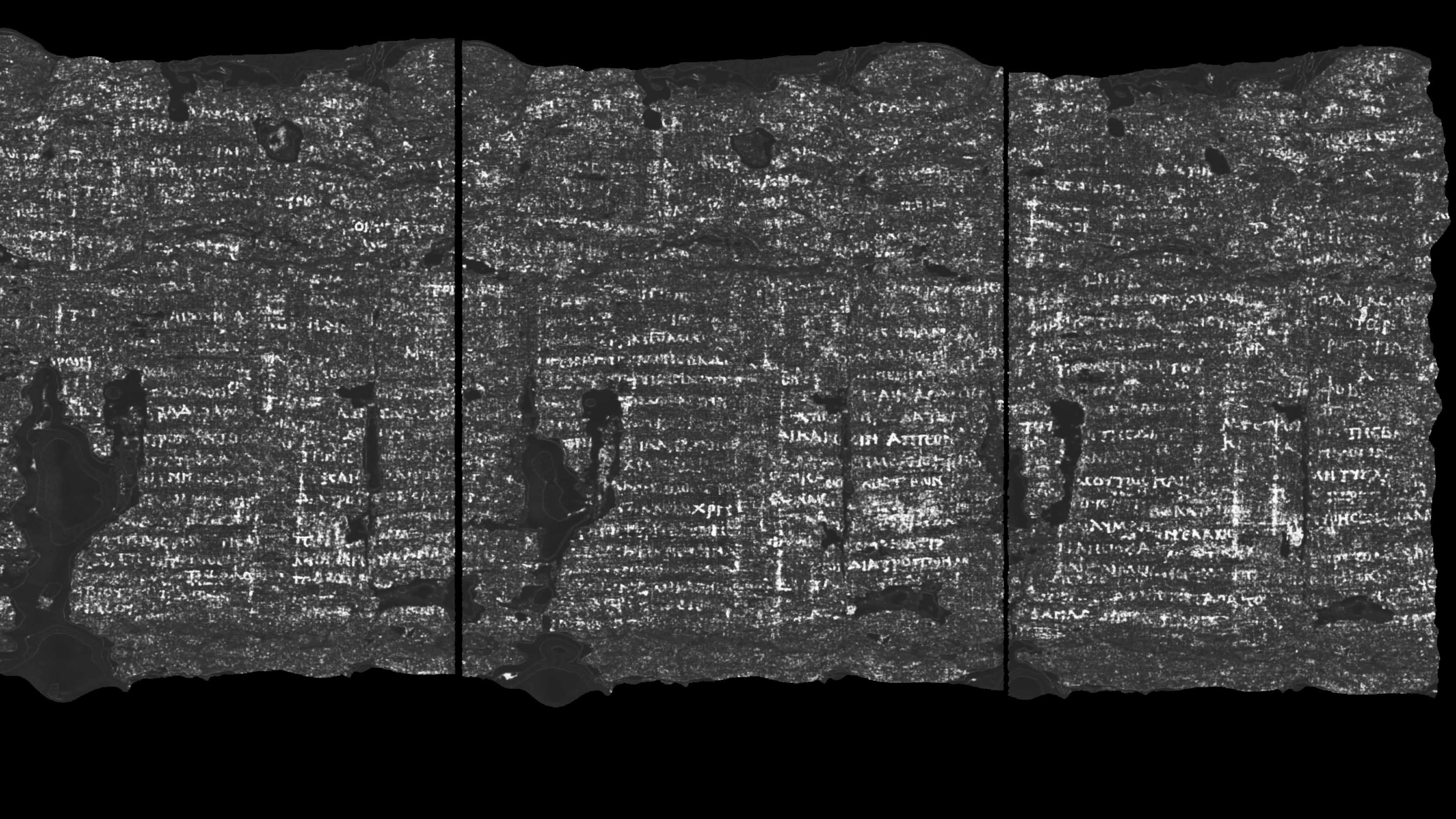A Herculaneum scroll buried by Mount Vesuvius’ eruption almost 2,000 years ago is finally legible, now that researchers have used artificial intelligence (AI) and a particle accelerator to peer inside the charred artifact.
While the majority of the ancient Greek text is still undeciphered, researchers have identified the words for “foolish” (ἀδιάληπτος), “fear” (φοβ), “disgust” (διατροπή) and “life” (βίου). The team hopes to put these words into context as they analyze the rest of the scroll’s contents.
The scroll, named scroll PHerc. 172, is one of many that survived the eruption of Mount Vesuvius in A.D. 79. The eruption spat out a pyroclastic flow of volcanic ash, toxic gases and other materials that killed nearly 2,000 people in the ancient Roman cities of Pompeii and Herculaneum while burying thousands of artifacts, including the scrolls.
The scrolls were burned and then carbonized in the eruption’s aftermath. Today, they are blackened, charred and far too fragile to open, so researchers are using technology to unlock their contents.
A team of librarians, computer scientists and scholars announced on Wednesday (Feb. 5) that they had successfully recovered text from PHerc. 172, which is held at the University of Oxford’s Bodleian Libraries. Researchers used a synchrotron — a kind of particle accelerator — to produce high-resolution X-ray images of the scroll and AI to detect ink on its pages.
“It’s an incredible moment in history as librarians, computer scientists and scholars of the classical period are collaborating to see the unseen,” Richard Ovenden, head of gardens, libraries and museums at the University of Oxford, said in the statement. “The astonishing strides forward made with imaging and AI are enabling us to look inside scrolls that have not been read for almost 2,000 years.”
Related: 1,900-year-old papyrus ‘best-documented Roman court case from Judaea apart from the trial of Jesus’
Discovering ancient words
Archeologists excavated the scrolls in Herculaneum in the 1750s. In the early 19th century, Ferdinand IV (who lived from 1751 to 1825), king of Naples and Sicily, later gifted PHerc. 172 and five other scrolls to the then future king of the U.K., George IV, who went on to rule between 1820 and 1830. Ferdinand reportedly gave the scrolls to George in exchange for kangaroos.
In 2024, researchers scanned PHerc. 172 in the U.K.’s national synchrotron research lab, Diamond Light Source. The synchrotron accelerates electrons to almost the speed of light, producing intense light that is 10 billion times brighter than the sun, according to Diamond Light Source. Because the light is mainly in the X-ray part of the electromagnetic spectrum, the synchrotron acts like an X-ray machine, only 100 billion times brighter than a standard hospital X-ray machine.

Bodleian Libraries teamed up with computer scientists at Vesuvius Challenge, an AI-based competition for deciphering Herculaneum scrolls, which used AI to enhance the clarity of the text revealed in the synchrotron scans, according to the statement.
So far, the words decoded point to philosopher and poet Philodemus of Gadara (who lived from around 110 to 30 B.C.). The handwriting in PHerc. 172 is similar to other scrolls attributed to Philodemus and the word “foolish” is characteristic of his work, according to Vesuvius Challenge.
Vesuvius Challenge’s machine learning tool can detect ink but doesn’t understand language or recognize characters like ChatGPT and other large language models. Thus, humans still have to work through ink strokes that the tool finds to decipher the ancient texts within the scroll.
“This scroll contains more recoverable text than we have ever seen in a scanned Herculaneum scroll,” Vesuvius Challenge co-founder Brent Seales said in the statement. “Despite these exciting results, much work remains to improve our software methods so that we can read the entirety of this and the other Herculaneum scrolls.”
In 2023, a Vesuvius Challenge contestant used AI to become the first person to identify a word and several letters from a Herculaneum scroll scorched and buried by the Mount Vesuvius eruption. The word, from another scroll, was πορφύραc in ancient Greek, which means “purple dye” or “clothes of purple.”
